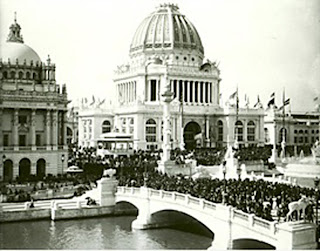On Friday September 28, 2012 at 7:00pm , the museum is proud to host a production of “The White City.” This original musical, produced by Lost and Found Productions and playwright June Finfer, focuses on one of the most legendary events in Chicago
When Chicago United States
June Finfer is an award-winning writer, and a producer of documentaries. Her film about the architecture of Mies van der Rohe has been broadcast on A&E and PBS and won a first prize at the American Film Festival.
Pre-paid tickets are $25.00 per person and may be purchased by calling 312.326.1480 . The production will take place in the coach house of Glessner House Museum 1800 S. Prairie Avenue Chicago South Loop neighborhood.
John and Frances Glessner made numerous trips to the fairgrounds, which are recorded in Frances
In a manuscript entitled “Ghosts of Yesterday,” John Glessner recalled some of the individuals who visited 1800 S. Prairie Avenue
“Other dear and delightful friends were Mr. and Mrs. Frederick Law Olmsted. Our families were on very intimate terms. George and young Frederick were classmates in College (Harvard). During the World’s Fair Mr. and Mrs. Olmsted visited us. He was America
“It was (Charles) Hutchinson, too, who first brought Sir Caspar Purden Clarke, Director of the Metropolitan Museum of Art, New York, possessing a great and thorough knowledge of art but never forcing his knowledge or position on one – another cultured Englishman, with all that that implies. As he left our dining room he said to Hutchinson Hutchinson Siam
“The World’s Fair brought us many pleasing experiences with men and things, both in the early days of preparation and later in the installing of exhibits and the display itself. It brought, also, some official representatives from abroad that our authorities treated very well, better than some of them deserved. Special attention was paid to the Spanish representative. I think the Duke of Veragua was never in my house, but I had some small connection with his entertainment – once at a horse show on the Dunham farm at Wayne, where Arthur Caton was in charge and asked my help; and again at South Bend, where the first Clement Studebakers were entertaining the “royal” party at luncheon, where I witnessed the most marvelous exhibition of hospitality. We went from Chicago
“Perhaps it was not only the Chatelain that brought these World’s Fair men to us. There was the daughter of the house – only a child then, it is true, but good company even then. (Fanny Glessner was 15 years old at the time of the Fair). There was the freedom of the house, a man might come or go as he pleased, he might talk or merely listen, he might read or merely sit and contemplate; there was a willing ear to hear and a heart to sympathize in their troubles, and there were creature comforts as well – always a good Sunday supper, and as with the proverbial stage or street car, there was at table always room for one more. This house was a haven of refuge for many, the shadow of a great rock in a weary land, and these friends brought many amusing tales. One gay young visitor came home one day from the Fair to say that going into one building she met an elderly man coming out who apparently had no one to talk with and who was oppressed by the size of the thing and the short time at his disposal, and perhaps encouraged by her winning smile broke out with, “I can’t see the damned thing in a month.”
“And we had the World’s Fair architects – Burnham, and John Root, before his untimely death, and Charles Follen McKim, and Robert Swain Peabody, and William R. Meade, and (John Goddard) Stearns and George B. Post, and Charles Coolidge, who built the present Art Institute for religious and other conferences during the Fair, and who restrained his impatience one night until everybody else had gone that he might tell us of his love romance that had culminated in acceptance the day before in St. Louis.”








